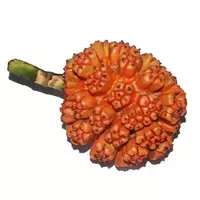Pandanus (chiura)

The pandan or pandanus (chiura) plant cannot be called typical of our latitudes. This genus of tree plants, assigned to the pandan family, has about 750 diverse species that grow mainly in the tropical climate of the countries of Southeast Asia. As a rule, Pandan fruits are eaten, useful or Pandanus utilis. The birthplace of the plant is considered to be Puerto Rico, as well as Madagascar and Mauritius.
It is worth noting that the fruits of pandanus (chiura) resemble pineapple in their appearance. Currently, the pandanus (chiura) plant grows in its natural habitat, and is also cultivated in countries such as: Africa, Australia, Madagascar, the USA, the countries of Southeast Asia, as well as the Pacific islands located in tropical and subtropical climatic zones. It is noteworthy that the plant pandanus (chiura) is often mistaken for a palm tree.
Among the numerous species of pandanus (chiura), you can find both stunted and small shrubs, and indeed giant trees reaching a height of more than 30 meters. In addition, pandanus (chiura) refers to those rare plant species that are little susceptible to various diseases. also pandanus (chiura) is distinguished by its resistance to the external effects of pests. Often, due to the peculiarities of the biological structure of the leaves, the pandanus (chiura) plant is called nothing more than a screw palm.
Some pandan species resemble dracena or yucca. The pandan blooms in small inflorescences, which are collected in a long brush. When the pandan blooms, everything around it is filled with the wonderful aroma of the plant's flowers. As previously noted, pandan fruits are somewhat similar to pineapples. It is worth emphasizing that on some islands of Oceania, pandan is considered a mandatory food in the daily diet of Aboriginal people.
Often called a "wandering tree, " the plant is equipped with so-called stilt roots. Not only pandan fruits original in appearance are eaten. Fragrant and fragrant pandanus (chiura) leaves are widely used in the cooking of the plant's growing countries. The pandanus (chiura) leaves are twisted into knots and then used as a seasoning for homemade baking. In addition, pandan leaves are used in the process of preparing meat dishes.
As a spice, pandan leaves give a special aroma to meat. As a component of the curry mixture, pandan leaves are used in Thailand, India, Sri Lanka, Indonesia and Malaysia. In addition to leaves, dried pandan flowers are used as a spice. However, flowers have a less pronounced spicy smell than leaves.
For the Asian culinary tradition, pandan leaves play an important role. Pandan leaves are added when making rice dishes as well as side dishes. often pandan leaves are used as banana leaves. The products are wrapped in pandan leaves and baked.
Pandanusa (chiura) 0.1 kCal
Energy value of pandanus (chiura) (Ratio of proteins, fats, carbohydrates - ju):
Proteins: 0 g (~ 0 kCal)
Fats: 0 g (~ 0 kCal)
Carbohydrates: 0 g (~ 0 kCal)
Energy ratio (b | y): 0% | 0% | 0%
 Español
Español Français
Français Português
Português Русский
Русский 简体中文
简体中文 繁體中文
繁體中文 日本語
日本語 한국어
한국어 العربية
العربية Türkçe
Türkçe Қазақ
Қазақ Deutsch
Deutsch Italiano
Italiano Українська
Українська
